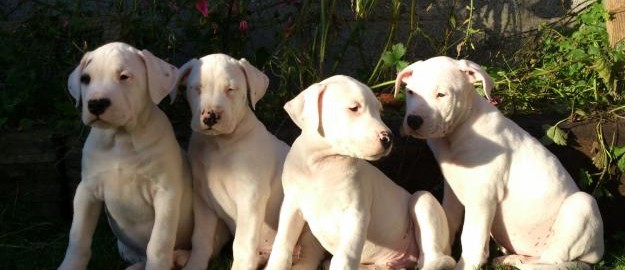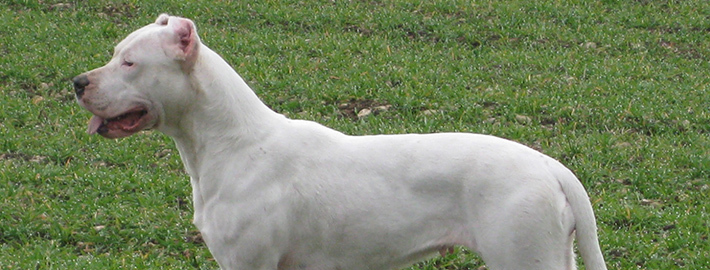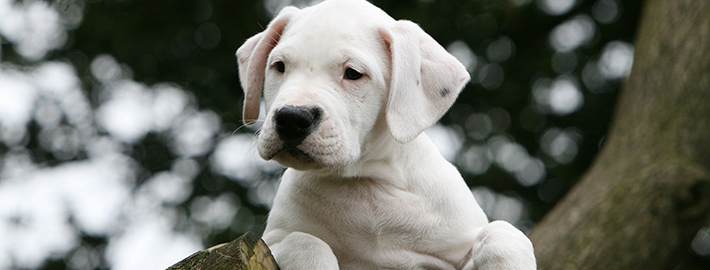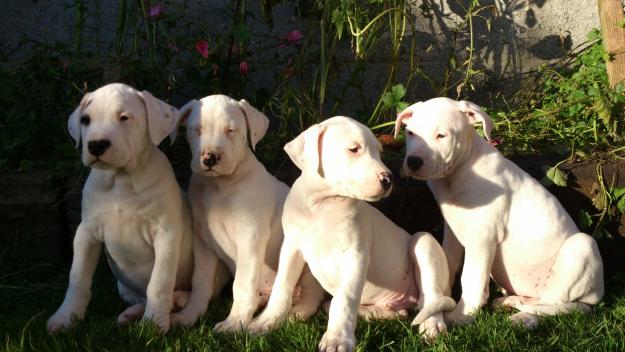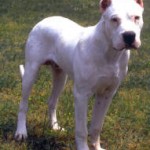What makes the Argentine Dogo Unique?
This breed originated in Cordoba, the central region of Argentina, at the hands of Dr. Antonio Nores Martinez. Dr. Martinez methodically crossed a total of ten breeds, including a now-extinct breed of dog from Cordoba, in pursuit of an athlete with the strength of body and character to perform difficult work, yet a friendly and amiable personality which allows him to live and work cooperatively. Dr. Nores Martinez’ brother, family and their close compatriots continued his early success after his untimely death. The breed has proved to be valiant hunter of country predators, as well as an excellent companion for active, experienced families.
Breed Groups
Page Contents
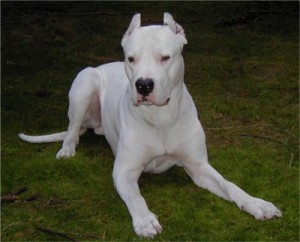
Is the Argentine Dogo Right For You?
The Dogo is a cheerful, humble, and friendly breed; and not a hard barker. He loves his family, especially children. The mature Dogo needs extensive regular exercise to maintain its athletic condition and pleasant disposition. They are clean dogs that need little coat care. Dogos, like all dogs, respond well to positive, balanced obedience training, and make excellent companions for the right families, though their working prey drive and need for serious physical and mental stimulation must always be kept firmly in mind.
In 5 Words
- Tolerant
- Protective
- Loyal
- Friendly
- Cheerful
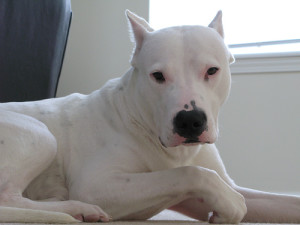
Characteristics
Learn About the Argentine Dogo
Description
The Dogo Argentino is also called the Argentinian Mastiff or Argentine Dogo. It is a large, well muscled dog. The deep-set chest is wide. There is an abundance of skin on the muscular neck. The head is massive with a rounded shape from front to the back. The muzzle concaves upwards slightly, with a slight stop and is about the same length as the skull. The jaws are strong. The teeth should meet in a scissors bite. The nose is black. The eyes are set well apart, and are dark brown, light brown or hazel in color. The rims of the eyes should be pink or black. The ears are set high and are usually cropped to make them stand erect, and triangular in shape. The thighs are very muscular with a short hock. There are usually no dewclaws. The thick tail is long and carried naturally low reaching the hock. The thick, glossy coat is white and has no undercoat. While not accepted in all clubs, sometimes the Dogo Argentino can have a black spot on the head known as “pirata”. This trait in the Dogo´s coat is accepted by Federacion Cinologica Argentina.
Short History of the Argentine Dogo
In the 1928, Antonio Nores Martinez. a medical doctor, professor and surgeon, set out to breed a big game hunting dog that was also capable of being a loyal pet and guard dog. Antonio Martinez picked the Cordoba Fighting Dog to be the base for the breed.[19] This breed is extinct today but was described as a large and ferocious dog that was a great hunter. He crossed it with the Great Dane, Boxer, Spanish Mastiff, Old English Bulldog, Bull Terrier, Great Pyrenees, Pointer, Irish Wolfhound and Dogue de Bordeaux.[19] Nores Martinez continued to develop the breed via selective breeding to introduce the desired traits. Dr. Raul Zeballos introduced the Dogo Argentino to the United States in 1970.
Temperament
The Dogo Argentino is an excellent guard dog that will protect it’s family with fervor. This breed, while ferocious when called for, is known to be excellent with children and thoroughly enjoys cuddle time. However, this is a considerably large breed and care should be taken around small children to ensure accidents do not happen during play. The Dogo Argentino is known to get along well with non-canine pets, provided they are introduced form puppy-hood. It is not uncommon for the Dogo Argentino to display some aggression towards other dogs, however, they will rarely instigate a situation. It is necessary to begin socialization with this breed from a very young age as well as to make it clear to the dog that it is not his job to put another dog in his place.
Caring for Your Argentine Dogo
General Health
This breed has a sky-high rate of hip dysplasia. The Orthopedic Foundation of America evaluated the hip X-rays of 120 Argentine Dogos and found 37.5% dysplastic – the 12th worst rate of 142 breeds. And the true rate is even higher because most of the obviously bad X-rays were not sent in for official evaluation.
Other orthopedic diseases in the Argentine Dogo are elbow dysplasia, osteochondritis, and panosteitis.
Inherited deafness affects about 10% of the breed.
Skin diseases are extremely common in Dogos – especially allergies (which cause itchy skin), chronic bacterial skin infections (pyoderma), and demodectic mange.
The most common eye diseases in the Argentine Dogo are eyelid abnormalities (entropion and ectropion).
As with all deep-chested breeds, Dogos are at higher-than-normal risk for the emergency gastrointestinal syndrome bloat.
.
Grooming & Bathing
The single white coat is very easy to care for. Brush occasionally. Keep nails trimmed. They have no doggy odor. This breed is an average shedder.
Exercise & Training
Give this dog plenty of exercise. They need to be taken on a daily, long walk or jog.

